5. Dawn of the Dead
(George Romero, 1978)
“When there’s no more room in Hell, the dead will walk the Earth.”
Back before the zombie genre exploded in poularity circa 2004 (with the release of 28 Days Later, Shawn of the Dead, and Zack Snyder’s Dawn of the Dead remake), George Romero was the undisputed king of the form, producing an entry in his “of the Dead” series roughly once a decade. Beginning with the seminal 1968 classic (and Countdown inductee) Night of the Living Dead, the series continued ten years later with Dawn of the Dead, heralded by many as superior to its predecessor, and perhaps the greatest zombie film ever made.
The film opens with civilization on the brink of collapse due to a zombie outbreak at a slightly more advanced stage than the one seen in Night (later entries in the series would continue this trend of amping up the “progress” of the zombie apocalypse). Four people, including two disillusioned SWAT officers, a TV News chopper pilot, and the pilot’s pregnant girlfriend, decide to steal the station’s helicopter and escape together. After a few risky refueling stops, they decide to seek out more permanent shelter, and eventually come across a shopping mall complex. The quartet soon convert the mall into a passable fortress: they hole up in a hidden storage room in the attic, and make supply runs to the many stores below. They hotwire trucks in the parking lot to block the doors, eliminate the zombies already inside the mall, and before long the four have a consumerist paradise all to themselves.
But, as established in Night, the greatest danger in zombie movies isn’t the zombies, it’s other people. One day, a roving band of motorcycle thugs spots the chopper parked on the mall roof. The gang smash their way inside, letting in the undead legions once more. As the bikers run around the mall goofing off (one wonders how they survived this long to begin with) they are slowly picked off by the ghouls, as are two of our protagonist survivors. As their shelter is destroyed around them, the two remaining “good guys” (one SWAT member and the pilot’s girlfriend) escape to the roof, board the helicopter, and take off to an uncertain future.
There’s a lot that this film does well. A shopping mall makes a fascinating choice of setting – not only does it offer lots of different venues and possibilities for interesting zombie kills, but it also seems like a downright fun place to spend the apocalypse. One of the film’s most memorable scenes has the survivors simply enjoying themselves in the now-vacant mall: putting on mock fashion-shows, “robbing” the bank, and even playing racing and shooting games at the arcade. The setting also offers some subtle social critique (something for which Romero’s zombie films are often lauded). Toward the end of the Seventies, malls were just beginning to become popular hang-out spots, and the film likens mall-goers, vacantly wandering from store to store in the name of consumption, to the throngs of mindless, marauding ghouls.
Two other factors push strongly for Dawn‘s inclusion in the Countdown: First, it marks the first collaboration between Romero and makeup wizard Tom Savini. While in Night we never saw a zombie actually bite a person directly, here we see people straight-up PULLED APART by the undead in ropey, cheesy, pizza-like strands. Heads explode, limbs are yanked off, screwdrivers are stabbed into brains, and many a jugular gets nommed upon. Dawn still stands as one of the goriest films ever made, and the visceral power of Savini’s effects leaves me disappointed every time The Walking Dead resorts to a slipshod computer effect (this happens a lot).
Second, the film features a great soundtrack by electronica band Goblin. Rather than “music,” it’s more of a soundscape, with the ominous burbles, synthesizer waveforms, and occasional guitar riffs serving at turns to perfectly accentuate moments of horror, heart-pounding excitement, and even morbid comedy. The end credits music, a carnival-like instrumental piece called “The Gonk” overlaid with zombie moans, superbly caps off the half-silly, half-sinister tone of the entire film (the tune can now be heard as the end-credits music of Seth Green’s Robot Chicken).
So why does Night outrank Dawn in my mind? Mostly because of the formative influence that seeing Night at nine years old had on me. Additionally, Night tells more of a complete story, while Dawn feels unresolved. Initially, Dawn was to end with the final two survivors…well, not surviving. The remaining SWAT officer was to succumb to the zombies, and the girl was to be beheaded by the blades of the chopper while attempting to escape. During the credits, the blades of the copter would wind down, revealing that they didn’t have enough gas to get away anyway. This is super bleak, and perhaps too similar to the end of Night, so I guess I’m glad they changed it.
All the same, Dawn stays here, where it belongs.
Tidbits: Tom Savini cameos as “Blades,” the biker armed with a machete. He would reprise his role three decades later in Romero’s 2008 film Land of the Dead.
-The Monroeville Mall in Pennsylvania, where the movie was filmed, was and still is a real, operating shopping mall. Romero and Co. would begin work as soon as the mall closed for the night, and clean up before it opened every morning. With the copious amounts of blood, I’m sure they missed a spot at least once.
-Ken Foree, who plays Peter (the black SWAT officer) was totally the dad on Kenan & Kel.
(Ken Burns, 1990)
Here’s to Ken Burns, the man who proved that looking at photographs for ten straight hours could be just as captivating as any action sequence.
Over the course of the official Countdown, I seriously neglected the documentary form. I decided to rectify that inequity in the Honorable Mentions if I could…but if I could only address one more documentary, which would it be?
In my post on Merlin, I recalled my fond memories of looking forward to the evening broadcasts of that miniseries. Well, a few years later I felt that same anticipation when The Civil War was aired on PBS, remastered, in 2002. But in this case, the anticipation stretched over 9 days instead of 2! Unfortunately, Burns’ documentary lacks wizard duels of any kind, and as such has been relegated to Honorable Mention status.
Kidding aside, The Civil War represents a Herculean cinematic undertaking. Burns spent five years making the film…longer than it took to fight the Civil War in the first place. He drew heavily from authentic media of the period, and incorporated thousands of images, documents, and quotations related to the War. Particularly prominent is the work of photographer Matthew Brady, widely regarded as the first photo-journalist, and certainly the first to follow along with military units during wartime. Historian David McCullough provides narration for the series, and interviews with a handful of other Civil War historians are interspersed throughout. A wide assortment of actors (including a few celebrities, such as Morgan Freeman and Jeremy Irons) read quotations from historical figures important to the War.

Sullivan Ballou, a Union soldier best remembered for an eloquent letter he wrote his wife from the front, just a week before dying in battle. A dramatic reading of the letter concludes an early installment of the film.
Like Dawn of the Dead, The Civil War has an exceptional soundtrack. In addition to emotional renditions of period tunes such as “Dixie” and “Battle Hymn of the Republic,” the film prominently features the unforgettable “Ashokan Farewell,” a haunting but modern composition which serves as the series theme.
The epic length of this film (at what point does a mini-series just become a TV show?) effectively conveys the vast scope of the Civil War. The War’s chronology is thoroughly addressed, but more important is the human drama at the core of the story. As the deadliest war in American history, the conflict left an indelible influence on our nation. Burns’ documentary provides arguably the best single representation to date of four of the most divisive, bloody, formative years in our national story. As Abraham Lincoln might say,
The world will little note nor long remember what I say here, on this blog. Through years of dedicated work, and drawing on the resources of countless historic libraries and personages, Ken Burns created a film which is consecrated far above my poor power to add or detract.
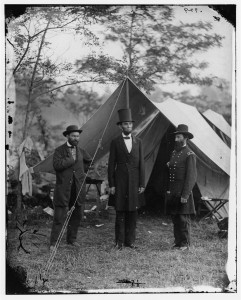 The Civil War remains the single most-watched program ever aired on PBS.
The Civil War remains the single most-watched program ever aired on PBS.
And deservedly so.
Tidbits: Okay, this isn’t exactly “tidbit” material, but I wanted to address it apart from the main flow of the post. I found the most poignant, jaw-dropping moment in this ten-hour behemoth to be the film footage (with sound!) of the memorial celebration marking the 75th anniversary of Gettysburg. It’s hard to believe that that much time had already passed by 1938…and harder still to believe that veterans of the war were STILL ALIVE at the time. Seriously. FDR is on film, delivering a speech as real live CIVIL WAR VETERANS decked in their old blue and gray meet and shake hands. Just over a year later, World War II would break out in Europe.
That’s nuts.
3. Scooby-Doo on Zombie Island
(Jim Stenstrum, 1998)
I will not tell a lie. I like zombies. Even now, in their done-to-death ubiquity, I still like zombies. There’s something so fundamentally wrong about dead people getting up and moving around again that variants on the theme make up perhaps half of all “horror” narratives, with ghosts, vampires, Frankenstein, and similar “undead” horrors stretching all the way back to the revenants and draugrs of the middle ages and beyond. But the zombie as interpreted by George Romero is something special. Maybe it’s because zombies (in the slow, shambling sense) act and move most similarly to the way a “real” corpse might. They represent the nadir of the uncanny valley (as the handy chart below attests): They look almost exactly human, but their behavior is off enough to cause revulsion and, yes, horror.
 All that said, I feel a closeness to this film which extends even beyond my affinity towards zombies. Scooby-Doo on Zombie Island was a feature-length film released directly to home video in 1998. The story takes place some years after the events of the original Scooby-Doo, Where are You? TV series (except that it’s the late-90s “present,” rather than the 60s). The Mystery Inc. gang have gone their separate ways: Shaggy and Scooby work as customs inspectors at an airport, Velma owns and operates a mysteries-only bookstore, and Daphne is the host of a successful talk-show which Fred produces. The film opens like the tail-end of a standard Scooby episode, with the gang trapping and unmasking a “monster,” but then dissolves to the set of the talk-show, where Daphne has been reminiscing about the “good old days” to her guest and audience. Noting her nostalgic tone, Fred decides to organize a reunion as a birthday surprise for Daphne. With nothing better to do (Velma realizes “solving mysteries is a lot more fun than selling them”; Shaggy and Scooby get fired for eating confiscated contraband food) the gang enthusiastically reconvenes.
All that said, I feel a closeness to this film which extends even beyond my affinity towards zombies. Scooby-Doo on Zombie Island was a feature-length film released directly to home video in 1998. The story takes place some years after the events of the original Scooby-Doo, Where are You? TV series (except that it’s the late-90s “present,” rather than the 60s). The Mystery Inc. gang have gone their separate ways: Shaggy and Scooby work as customs inspectors at an airport, Velma owns and operates a mysteries-only bookstore, and Daphne is the host of a successful talk-show which Fred produces. The film opens like the tail-end of a standard Scooby episode, with the gang trapping and unmasking a “monster,” but then dissolves to the set of the talk-show, where Daphne has been reminiscing about the “good old days” to her guest and audience. Noting her nostalgic tone, Fred decides to organize a reunion as a birthday surprise for Daphne. With nothing better to do (Velma realizes “solving mysteries is a lot more fun than selling them”; Shaggy and Scooby get fired for eating confiscated contraband food) the gang enthusiastically reconvenes.
Daphne uses the reunion as a handy excuse to launch a new segment for her show. After years of chasing bad guys in masks, she now intends to track down a “real live ghost” (apparently this movie doesn’t take place within the same canon as The 13 Ghosts of Scooby-Doo, in which Daphne encountered real ghosts all the time). So Mystery Inc. hits the road once more…and finds that, as before, the preponderance of paranormal activity is still the handiwork of masked impostors all too easily thwarted by meddling kids.
At a stop-off in New Orleans, however, the gang is invited by a local woman named Lena to come film at a bayou plantation home, “a house that really is haunted.” They follow Lena to the ominous-sounding Moonscar Island, site of an early Louisiana settlement. Throughout the centuries, the island has played host to Civil War encampments and pirate attacks, with the island itself being named for notorious pirate captain Morgan Moonscar. The gang stays at the mansion of Lena’s employer, Simone. Right off the bat, supernatural happenings begin to occur. At first, Fred et. al go about “solving the mystery” as usual, with suspicions aimed at shifty backwoodsman Snakebite Scruggs (voiced by Luke Skywalker himself, Mark Hamill) and Simone’s strapping new gardener, Beau. But then something unprecedented (at least in this canon) happens. Zombies start appearing all over the island…gruesome, withered, and very, very real. The gang becomes aware of the undead menace at various times. Shaggy and Scooby, of course, are the first to encounter the ghouls, bumping into the walking husk of Morgan Moonscar himself about halfway through the film. Gradually, the zombies become harder to ignore or write off as impostors. Near the climax of the film, Fred captures a zombie and attempts to “unmask” it…and comes away with a severed, still groaning head.
Panicked, the gang seeks the help of Lena and Simone, who, in an excellently-executed twist for a kids’ movie, turn out to be the true villains. They are soul-sucking “werecats,” and have been surviving since colonial times by feeding on the life-essence of any people foolish enough to venture to the island. The centuries-worth of zombies are their victims, and these ghouls were in fact trying to warn Scooby and co. away from the island. With some quick thinking (and a few improvised voodoo dolls), the gang is able to stall the soul-sucking ceremony long enough to finally kill the cat-monsters, allowing the zombies to rest in peace at last. The Mystery Inc. crew finally knows what Shaggy and Scooby have suspected for years: that real monsters are out there. Too bad they lost their TV equipment in quicksand, huh?
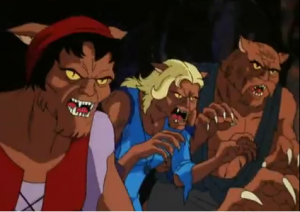 Admittedly, Scooby-Doo on Zombie island is a direct-to-video cartoon aimed squarely at the young demographic i belonged to when it first came out. Nevertheless, it demonstrates skillful storytelling and some impressively macabre scares. It breathes new live into the classic Scooby characters and formula, adding in the grim new possibility of “real monsters.” Though targeted at a young audience, it’s markedly more mature than the live-action Scooby films released in the decade to follow. And, like Dawn of the Dead and The Civil War, it features a killer soundtrack.
Admittedly, Scooby-Doo on Zombie island is a direct-to-video cartoon aimed squarely at the young demographic i belonged to when it first came out. Nevertheless, it demonstrates skillful storytelling and some impressively macabre scares. It breathes new live into the classic Scooby characters and formula, adding in the grim new possibility of “real monsters.” Though targeted at a young audience, it’s markedly more mature than the live-action Scooby films released in the decade to follow. And, like Dawn of the Dead and The Civil War, it features a killer soundtrack.
The film sold so well that it launched an entire series of direct-to-video Scooby movies which continue to be released annually to this day. None has yet eclipsed Zombie Island in my book. Revived interest in Scooby and the gang also spurred the creation of What’s New, Scooby-Doo? , a new incarnation of the TV series.
P.S.: I read an intriguing, well-written op-ed article once which made a compelling argument that the introduction of “real monsters” to Scooby-Doo invalidates the franchise’s central premise, namely that all mysteries can be puzzled out to a logical solution through the use of investigation and reason. The series has been championed by skeptic societies for encouraging children to examine critically any apparently “supernatural” phenomena, and especially to question authority. Throwing the possibility that spirits/magic/the paranormal really exist into the mix negates that message. However, as I argued in my 2013 “Creepy Classics Countdown” over at the Brian Terrill Movie Night page, “real monsters” in Scooby-Doo are hardly a Zombie Island innovation. Of the many different television series to star Scooby-Doo, roughly half (basically everything in the 80s) have featured real monsters. There were even three feature-length TV films with genuine ghosts and goblins: Scooby-Doo Meets the Boo Brothers, Scooby-Doo and the Ghoul School, and Scooby-Doo and the Reluctant Werewolf. I don’t see these incarnations as violating a central tenet of “Scoobyism,” but rather as simply trying something new. If you absolutely must reconcile the real monsters / no real monsters duality of the various Scooby series, I see two possible ways of going about it:
1. Since the different series generally operate one way or the other, simply accept that they take place in different canons and move on.
2. Since the series with “real monsters” tend to revolve around Shaggy, Scooby, and Scrappy traveling together without the rest of the group, I like to think that these series serve as prequels to the original Where are You? show. The reason Shaggy and Scooby are always terrified of the various ghosts the gang encounters is because they have encountered REAL ghosts previously. They’re not cowards. They’ve SEEN stuff, man. They know the truth…
2. The Rocketeer
(Joe Johnston, 1991)
According to Wikipedia, Chicago critic Jonathan Rosenbaum dismissed The Rocketeer as a hodgepodge of elements ripped-off from the Indiana Jones and Back to the Future series. Well, I’m about to praise it for pretty much that exact reason.
Directed by Joe Johnston (who also brought us The Pagemaster and Jumanji), The Rocketeer was an adaptation of a semi-obscure comic book by Dave Stevens. Like Lucas and Spielberg, Stevens was inspired by the action serials of the 40s, and drew on elements of these serials (most specifically, 1949’s “King of the Rocket Men”) to create his title character. The story follows Cliff Secord, a racing pilot living in 1930s Los Angeles. One day, he discovers an experimental jet-pack stashed in his hangar by gangsters on the lam. After a few tweaks from his engineer/tinkerer best friend, Secord is able to take to the sky, and the media dubs the mysterious flying man “The Rocketeer.” Now, Cliff must evade the gangsters, the federal government, a dashing spy hidden among Hollywood’s elite, and an even more insidious element lurking at the fringes…all of whom desperately want to possess / repossess / mass produce that fateful rocket.
Perhaps more than any other single film, The Rocketeer seems tailor-made according to a “things Brian likes to see in movies” checklist:
-A protagonist in a leather jacket (a particularly cool one at that) battling Nazis. Yeah, I know I said Bedknobs and Broomsticks was the only film released under the Disney label to feature Nazi antagonists. I was mistaken.
-A wacky, older, inventor best friend. “Peevy” (Alan Arkin) serves as Cliff’s plane mechanic and designs his Rocketeer flight-suit. He’s no Doc Brown, but then, who is?
-Tying in historical figures and events (often humorously): The jet-pack was designed by and stolen from aviation tycoon Howard Hughes; The film’s climactic Nazi-battle results in the destruction of both the Hindenburg and the final four letters of the HOLLYWOODLAND sign.
-The “period superhero” subgenre. This idea seems underutilized, considering how cool it is. Comic books have explored the superheroics of different eras at length, but these anachronistic adventures seldom make it to the screen (I guess there was that League of Extraordinary Gentlemen movie, which I still haven’t seen yet). With the recent explosion in “comic book movies,” I’m sure we will see more of this in the years to come.
While it may be nothing particularly groundbreaking, The Rocketeer is a fun blast from the past. It tells a conventional story, but as internet reviewer Harry Plinkett attests, it tells it effectively. Cliff saves the day, gets the girl (Labyrinth star Jennifer Connelly) and even patches things up with Howard Hughes, who gives him a new racing plane (to replace the one destroyed by errant gangsters in the film’s opening scene). And he does it all while looking really cool. The props and costumes department knocked it out of the park with this one: The jet-pack looks real, as though the stage-hands just might use it to zoom around the studio lot after-hours. And Cliff’s iconic costume remains one of the most memorable (albeit one of the more obscure) superhero outfits in film. When I spied the Rocketeer helmet on a shelf at Disney’s Hollywood Studios’ “backlot tour” ride, I gotta admit I had a little fanboy freakout. And then I saw the spaceship from Flight of the Navigator…but that’s another story.
1. American Psycho
(Mary Harron, 2000)
This one deserved a place on the Countdown. It shamefully slipped my mind…hopefully including it as the #1 Honorable Mention will appease any actual psychos among you who might feel slighted.
I have never seen another film quite like American Psycho. So as not to risk spoilers, let me start off by saying the movie is currently available on Netflix instant-watch. Go and watch it, then come back.
WAIT! Er, before you go and watch it, perhaps a warning is in order: This film depicts, or includes explicit references to:
-Numerous brutal murders
-Dismemberment
-Sexual abuse
-Implied cannibalism
-And also some drug use and profanity.
Not quite family-friendly stuff…
So, after that list of atrocities, how could this movie possibly merit “honorable” mention? Because it’s an unforgettable, darkly twisted character piece with a sardonic style all its own. It doesn’t quite seem like a true “horror film.” It has elements of a dark comedy, but I don’t know if you could really call it that either. It stands alone as simply American Psycho – and however you classify it, it will stick with you.
Christian Bale stars in one of his most memorable roles as Patrick Bateman, a successful young New York bussinessman of the 1980s. And as the film makes eminently clear from its earliest moments, success in Patrick’s world requires maintaining a “successful image.” The businessmen do all they can to jockey for power and a modicum of superiority over their fellows, and this petty one-upsmanship governs every aspect of their lives: “Workdays” consist almost entirely of making dinner reservations at elite restaurants (the more exclusive, the more impressive) and comparing business cards.
But Patrick (who also serves as our narrator) reveals that he is not quite identical to his co-workers. No, while these power-hungry men struggle to maintain a successful image, Bateman is his image, with only a soulless, emotionless void beneath. “There is an idea of a Patrick Bateman,” narrator-Patrick informs us. But it is a fabrication, a facade constructed via rigorous exercise and a wide assortment of facial cleansers. Beyond that, he says, “I simply am not there.”
The “real” Patrick Bateman is a sociopathic serial killer, hiding beneath his veneer of business acumen and flashy suits. At first, he limits his attacks to animals and the occasional homeless person. But then, Paul Allen arrives on the scene. A rival businessman at Bateman’s firm, Allen gets better reservations and sports a slicker business card.
He’s got to go.
One evening, Patrick invites Paul Allen to his apartment. He gets Allen drunk, then pops a Huey Lewis album on the CD player. In one of the film’s most iconic scenes, Bateman animatedly explains the song “Hip to Be Square,” as well as its place within American popular culture and the trajectory of Huey Lewis’ career. As he waxes poetic on the matter, Patrick dons a raincoat, grabs a gleaming axe, and chops Allen’s skull to spurting splinters.
The rest of the film proceeds at least partially in the way you might expect: The police investigate Allen’s disappearance, and, “Telltale Heart”-style, Bateman grows gradually more unbalanced and “psycho” as he attempts to avoid suspicion. This doesn’t mean he stops his crimes altogether of course – there’s still plenty of time to abuse prostitutes and attempt to court and kill his secretary, who has been crushing on him the whole movie.
As despicable as this all sounds, the real genius of the film comes through in a way you might not expect. You see, Patrick is an unreliable narrator.
Maybe.
It’s hard to tell whether the things Patrick tells us in his narration are true, or even whether the brutal acts we see him committing are “really” happening. Even MORE brilliant is that, despite all of Bateman’s perceived self-importance, it could be that the real reason he’s able to blend in so well isn’t due to his ability to create a flawless facade of “normalcy,” but rather because other people simply don’t care enough about him to look deeper than that. Each one of Patrick’s co-workers is busy acting out a charade of his own, in the pursuit of the materialistic ideal of “success” and happiness condemned by Tyler Durden in Fight Club. To them, Patrick is just another faceless suit, a mere obstacle to overcome. Repeatedly throughout the film, Patrick’s colleagues address him by the wrong name and seem to ignore or just not hear his casual references to infamous serial killers (as well as a few of his own depraved acts). While Bateman sees himself as a chameleonic criminal mastermind, the truth seems to be far different: Rather than a cunning demigod at the peak of physical perfection, he may be just a forgettable poser with delusions of grandeur.
And with that grim realization, the question as to whether he’s actually a murderer or not becomes of secondary importance. Psycho? Yep. But beyond that, it’s hard to say anything for certain about Patrick Bateman. As he hopelessly mutters in the film’s last line,
“This confession has meant nothing.”
This is quickly becoming a not-so-short review, so I will say only that Christian Bale perfectly pulls off his character’s blend of physical “perfection” paired with deep psychological imperfection. He’s at turns terrifying, half-charming, darkly funny, and hauntingly beautiful. Once you meet Patrick Bateman, you won’t forget him. Even though his coworkers might.
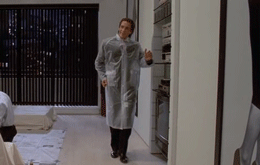 Tidbits: The critcally-acclaimed Showtime series Dexter borrows heavily from American Psycho, both thematically and stylistically. Like Patrick, Dexter is a serial killer effecting a false image of success and happiness, who fills the viewer in on the “true” state of things via internal monologue. The makers of the show acknowledged their debt in an episode in which Dexter obtains prescription sedatives under the alias of “Dr. Patrick Bateman.” Real subtle there, guys.
Tidbits: The critcally-acclaimed Showtime series Dexter borrows heavily from American Psycho, both thematically and stylistically. Like Patrick, Dexter is a serial killer effecting a false image of success and happiness, who fills the viewer in on the “true” state of things via internal monologue. The makers of the show acknowledged their debt in an episode in which Dexter obtains prescription sedatives under the alias of “Dr. Patrick Bateman.” Real subtle there, guys.
-CollegeHumor paid tribute to the film in a fittingly bizarre way. So, to provide the real, ultimate, final last word to the 100 Film Favorites Countdown,* here’s the star of the Countdown’s #1 entry (and the featured musical performer from #5) with an homage to my #1 Honorable Mention:
*Of course, I’ve still got to talk about Return of the Living Dead. Oh, and there’s Sour Grapes! The Lego Movie was great too. The Prince of Egypt deserved more coverage. And then of course there’s…



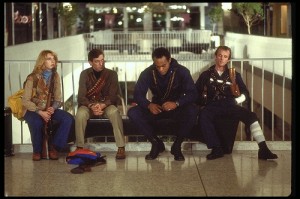
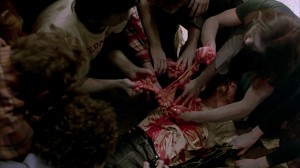
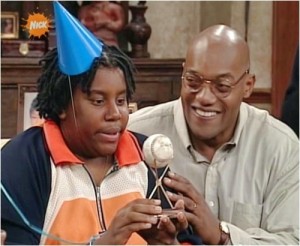

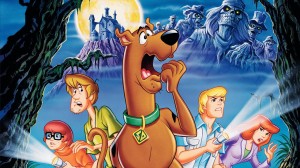

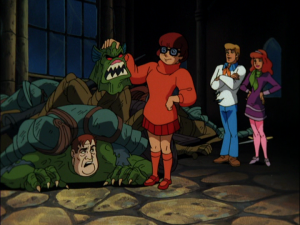
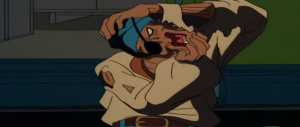


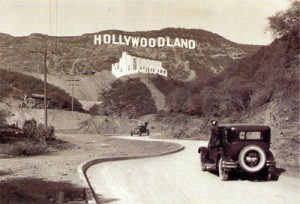
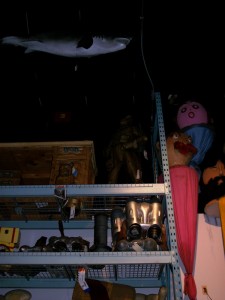
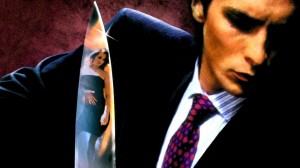

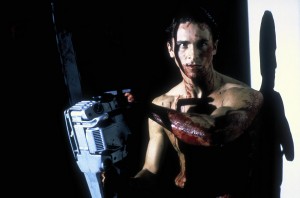



“Unfortunately, Burns’ documentary lacks wizard duels of any kind, and as such has been relegated to Honorable Mention status.”
Classic.